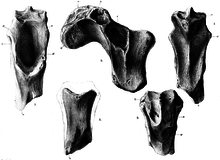
Stegosaurus is a genus of herbivorous, four-legged, armored dinosaur from the Late Jurassic, characterized by the distinctive kite-shaped upright plates along their backs and spikes on their tails. Fossils of the genus have been found in the western United States and in Portugal, where they are found in Kimmeridgian- to Tithonian-aged strata, dating to between 155 and 145 million years ago. Of the species that have been classified in the upper Morrison Formation of the western US, only three are universally recognized: S. stenops, S. ungulatus and S. sulcatus. The remains of over 80 individual animals of this genus have been found. Stegosaurus would have lived alongside dinosaurs such as Apatosaurus, Diplodocus, Camarasaurus and Allosaurus, the latter of which may have preyed on it.

Kentrosaurus is a genus of stegosaurid dinosaur from the Late Jurassic in Lindi Region of Tanzania. The type species is K. aethiopicus, named and described by German palaeontologist Edwin Hennig in 1915. Often thought to be a "primitive" member of the Stegosauria, several recent cladistic analyses find it as more derived than many other stegosaurs, and a close relative of Stegosaurus from the North American Morrison Formation within the Stegosauridae.
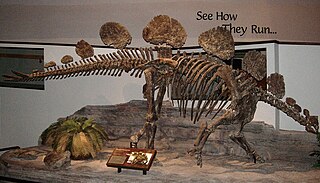
Hesperosaurus is a herbivorous stegosaurian dinosaur from the Kimmeridgian age of the Jurassic period, approximately 156 million years ago.
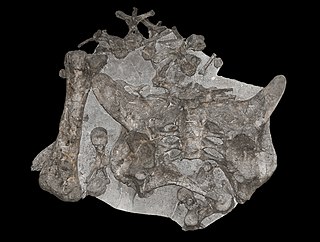
Dacentrurus, originally known as Omosaurus, is a genus of stegosaurian dinosaur from the Late Jurassic and perhaps Early Cretaceous of Europe.
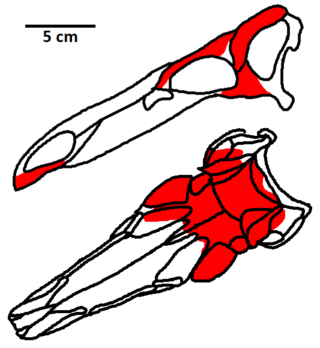
Dravidosaurus is a controversial taxon of Late Cretaceous reptiles, variously interpreted as either a ornithischian dinosaur or a plesiosaur. The genus contains a single species, D. blanfordi, known from mostly poorly preserved fossils from the Coniacian of southern India.
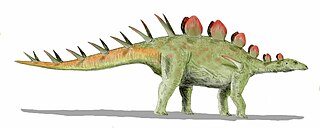
Chialingosaurus is a genus of herbivorous stegosaurian dinosaur similar to Kentrosaurus from the Upper Shaximiao Formation, Late Jurassic beds in Sichuan Province in China. Its age makes it one of the oldest species of stegosaurs, living about 160 million years ago. Since it was an herbivore, scientists think that Chialingosaurus probably ate ferns and cycads, which were plentiful during the period when Chialingosaurus was alive.

Wuerhosaurus is a genus of stegosaurid dinosaur from the Early Cretaceous Period of China and Mongolia. As such, it was one of the last genera of stegosaurians known to have existed.
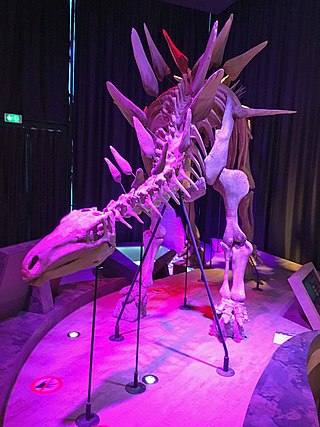
Lexovisaurus is a genus of stegosaur from mid-to-Late Jurassic Europe, 165.7-164.7 mya. Fossils of limb bones and armor fragments have been found in middle to late Jurassic-aged strata of England and France.

Paranthodon is a genus of stegosaurian dinosaur that lived in what is now South Africa during the Early Cretaceous, between 139 and 131 million years ago. Discovered in 1845, it was one of the first stegosaurians found. Its only remains, a partial skull, isolated teeth, and fragments of vertebrae, were found in the Kirkwood Formation. British paleontologist Richard Owen initially identified the fragments as those of the pareiasaur Anthodon. After remaining untouched for years in the British Museum of Natural History, the partial skull was identified by South African paleontologist Robert Broom as belonging to a different genus; he named the specimen Palaeoscincus africanus. Several years later, Hungarian paleontologist Franz Nopcsa, unaware of Broom's new name, similarly concluded that it represented a new taxon, and named it Paranthodon owenii. Since Nopcsa's species name was assigned after Broom's, and Broom did not assign a new genus, both names are now synonyms of the current binomial, Paranthodon africanus. The genus name combines the Ancient Greek para (near) with the genus name Anthodon, to represent the initial referral of the remains.

Stegosauria is a group of herbivorous ornithischian dinosaurs that lived during the Jurassic and early Cretaceous periods. Stegosaurian fossils have been found mostly in the Northern Hemisphere, predominantly in what is now North America, Europe, Africa, South America and Asia. Their geographical origins are unclear; the earliest unequivocal stegosaurian, Bashanosaurus primitivus, was found in the Bathonian Shaximiao Formation of China.
Monkonosaurus is a dubious genus of herbivorous stegosaurian dinosaur from the Late Jurassic/Early Cretaceous-aged Loe-ein Formation of Tibet. Some sources place it as alive during the Oxfordian - Albian stages, around 163 - 100 million years ago, although Monkonosaurus was probably only alive during the Late Jurassic, making it among the earliest known stegosaurs along with Chungkingosaurus and Bashanosaurus.

Hypsirhophus is a genus of stegosaurian dinosaurs. It contains a single species, Hypsirhophus discurus, which is known only from a fragmentary specimen. The fossil consists of partial vertebrae from the back, three from the tail, and a piece of rib.

Loricatosaurus is a Stegosaurid genus from Callovian-age rocks of England and France.

Alcovasaurus, alternatively known as Miragaia longispinus, is a genus of herbivorous stegosaurian dinosaur that lived in the Late Jurassic. It was found in the Morrison Formation of Natrona County, Wyoming, United States. The type species is Stegosaurus longispinus, later given the genus Alcovasaurus.

This timeline of stegosaur research is a chronological listing of events in the history of paleontology focused on the stegosaurs, the iconic plate-backed, spike-tailed herbivorous eurypod dinosaurs that predominated during the Jurassic period. The first scientifically documented stegosaur remains were recovered from Early Cretaceous strata in England during the mid-19th century. However, they would not be recognized as a distinct group of dinosaurs until Othniel Charles Marsh described the new genus and species Stegosaurus armatus in 1877, which he regarded as the founding member of the Stegosauria. This new taxon originally included all armored dinosaurs. It was not until 1927 that Alfred Sherwood Romer implemented the modern use of the name Stegosauria as specifically pertaining to the plate-backed and spike-tailed dinosaurs.

Susannah "Susie" Catherine Rose Maidment is a British palaeontologist at the Natural History Museum, London. She is also an honorary Professor at the University of Birmingham. She is internationally recognised for her research on ornithischian dinosaur evolution, and was awarded the 2016 Hodson Award of the Palaeontological Association and the 2017 Lyell Fund of the Geological Society of London. She was featured as a 2019 National Geographic Women of Impact.

Bashanosaurus is an extinct genus of stegosaurian dinosaur from the Middle Jurassic Shaximiao Formation of Yunyang County, China. The genus contains a single species, Bashanosaurus primitivus, known from incomplete skeletons belonging to three individuals. It is one of the basalmost stegosaurs, as well as one of the oldest known stegosaurs, along with Adratiklit, Isaberrysaura, and Thyreosaurus.

Baiyinosaurus is an extinct genus of stegosaurian dinosaurs from the Middle Jurassic Wangjiashan Formation of China. The genus contains a single species, B. baojiensis, known from a partial skeleton including cranial bones. The skeletal anatomy of Baiyinosaurus demonstrates transitional features between basal thyreophorans and stegosaurs. While many stegosaurs are known from China, Baiyinosaurus is the only one currently named from Gansu Province.
